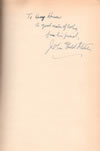
BH. John Gould Fletcher
13. Life is My Song: The Autobiography of John Gould Fletcher. New York: Farrar and Rinehart, 1937. Reprinted as The Autobiography of John Gould Fletcher, edited by Lucas Carpenter. John Gould Fletcher Series, vol. 2. Fayetteville: U of Arkansas P, 1988.
Several passages reveal the depth of Fletcher’s interest in East Asian tradition and his debts to it, but none more than his description of rediscovering the Oriental Wing of the Boston Museum of Fine Arts on his return to Boston late in 1914, after an absence of six years. In viewing the ‘Sung [and] Kamakura masterpieces’ he came to understand that he had been ‘deluded by the triumphs of western naturalism’. The artists of China and Japan, by ‘refusing to proceed along these lines’, had ‘achieved an art of . . . sustained spiritual intensity . . . rarely glimpsed’ in the West. He saw the work ‘with new eyes’, and was ‘re-educated’ about the ‘purposes’ of art and the ‘function of the poetic artist in reshaping the world’. He ‘rededicated’ himself ‘to the vital instinct’ and ‘the soul of nature’, realising that a ‘new life-giving spirit’, ‘not from the materialistic Occident, but from the traditional Orient’, could ‘create in western languages a new rhythm and a new vocabulary, a new form and a new feeling for the inter-relation of man and nature’. The effects of these understandings on Fletcher’s poetic enterprise were profound. More than before he ‘understood the nature of the task’ to which he had ‘dedicated’ himself. His aim would be ‘to fuse the East and the West’, to ‘combine the inner insight’ of Asia with the ‘restless, dynamic energy of modern America’. Though he later came to understand his ‘inadequacies for such a task’, in 1914 he believed that his work might help to achieve this ‘greatest and most profound necessity of twentieth-century humanity’ or lead even to some ‘advance of the human spirit that would be greater still, to some religion of the future that would combine the calm, detached self-awareness of Buddhism and the dynamic, passionate, world-awareness of Christianity’. The work includes equally illuminating passages about other matters related to this study, including Fletcher’s visits to the Art Institute of Chicago one or two months later and his composition there of the Japanese Prints (see 7), and his presence at gatherings in London some months earlier when Pound had introduced to Lowell the principles of Imagism, justifying them with Fenollosa’s essay about the ideogram (BK32) and his own hokku-inspired In a Station of the Metro (BK3). See also 31.





